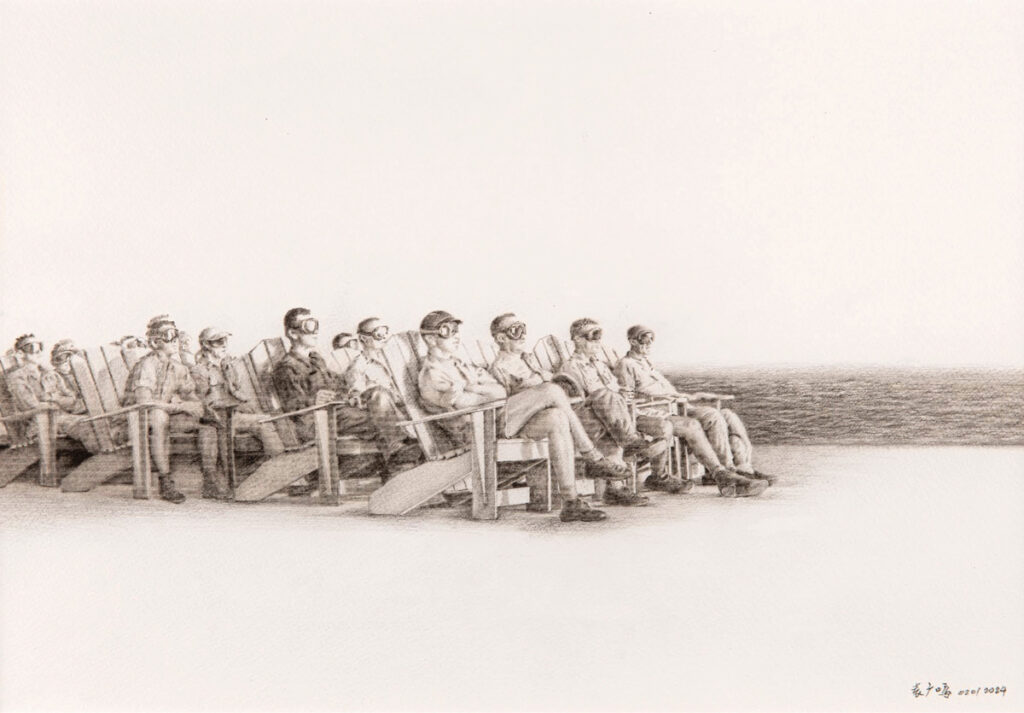An exhibition’s quietest artwork provides a key to one of its most important themes.
Among the room-sized video installations in Yuan Goang-Ming: Everyday War, full of motion and sound, one artwork might seem out of place: a modestly sized yet painstakingly rendered pencil drawing. Titled What Lies Beyond Us? (2024), it depicts an audience of men seated outdoors in rows of wooden chairs, gazing at something beyond the drawing’s frame. All wear tinted goggles that glint with the light of whatever bright spectacle holds their attention.
Their demeanor appears casual. Most are in shorts, with sleeves rolled up; some cross their legs. Only one visibly leans forward in his seat. At first glance, they may appear to be watching a 3D movie.
What they are witnessing, in fact, is an 81-kiloton nuclear explosion.
The drawing derives from an iconic photograph of American VIPs assembled in 1951 to watch a test detonation in the Marianas Islands. This was the dawn of the nuclear arms race. Scarcely five years after unleashing the most destructive weapon the world had ever known, the U.S. was rushing to develop even more powerful bombs.

The terrifying magnitude of what’s transpiring out of frame is hardly suggested by the prosaic image. The choice of seating, the Adirondack chair, seems particularly incongruous. The Adirondack is emblematic of rural getaways. It’s a porch-front staple of lakefront communities and mountain cottages, with a low recline intended expressly for relaxing outdoors and taking in a view. But on that April day in 1951, these men lounged in Adirondacks not to enjoy the tranquil South Pacific scenery, but to witness a cataclysmic nuclear blast.
Disconnects of this kind abound in Everyday War. Yuan Goang-Ming’s seamless, expertly composed video works offer ominous portrayals of contemporary life, yet through his deft craftsmanship, their imagery becomes subtle and seductive. Despite unsettling evocations of invasion and destruction, they play with a hypnotic slowness.
Even the exhibition’s title poses a quandary: is the specter of war so omnipresent now, so routine, that we scarcely notice it?
Today, imagery of conflict — past and present, fictional and real — saturates the media landscape, and we consume it passively alongside entertainment and ads. In What Lies Beyond Us?, the seemingly relaxed viewing of a nuclear detonation mirrors our own complacent, even voyeuristic, intake of disquieting images.
But as the title of What Lies Beyond Us? hints, often it’s not what we see, but what we don’t see — something absent, just out of frame — that Yuan Goang-Ming uses to evoke a feeling of looming danger and instability.
In Everyday Maneuver (2018), the usually busy streets of Taipei are strikingly empty due to Taiwan’s annual air raid drill, when residents take shelter in preparation for a nuclear attack. Meanwhile, The 561st Hour of Occupation (2014) records the occupation of Taiwan’s legislative parliament by the student “Sunflower movement,” during which the normally bustling halls of the building were eerily vacant.
In front of the exhibition’s most prominent screen, which shows both Everyday Maneuver and The 561st Hour of Occupation, visitors may notice a winking through-line in the artist’s choice of gallery seating: a row of Adirondack chairs.
Top image: Installation view of What Lies Beyond Us? (2024) at the Venice Biennale, 2024.